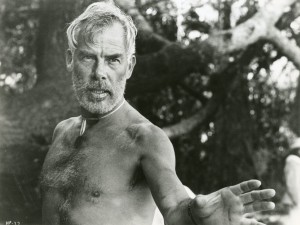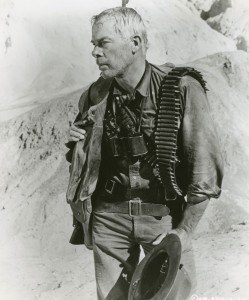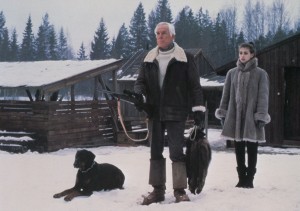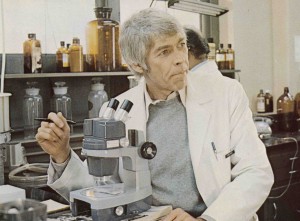
Today is Lee Marvin’s birthday. He would have been 100 today, had he not succumbed to a sudden heart attack in 1987, so I thought I should take this opportunity to celebrate his show business career, which lasted from 1951 until his death.
Lee Marvin survived World War II, after being seriously wounded at Saipan and spending more than a year in hospitals; his time in the Marines proved useful later on movie sets when he would serve as an unofficial technical advisor on military matters. Almost one third of Marvin’s sixty screen roles were served in uniforms of various colors and in ranks from salty sailors and lowly privates to canny colonels and meticulous majors. The Dirty Dozen became his biggest hit, yet his own anti-war views and sentiments prevented him from celebrating its success the way we fans did. He much preferred the two-person drama Hell in the Pacific, with its intimate struggle to understand and overcome the divisiveness of war.
Yet that image of battle became his persona. In film after film his characters battled opposing military forces, or organizations of authority, or maverick lawmen, or strong women. In some cases his characters battled themselves; in fact, he won an Oscar for Cat Ballou, in which he famously portrays two roles as brothers who battle to the death in a brothel. Although he was more than capable of holding his own in ordinary dramas (or comedies, for that matter), Marvin most often found himself outside, riding horses or motorcycles or Jeeps, either doing dastardly deeds or trying to stop others from doing them; climbing and hunting and shooting; sneaking rides on Depression-era trains or overseeing a crack military unit in response to a hijacking; marching through Florida’s Everglades as a cavalryman or kidnapping a child in Mexico City; running stolen rifles in the Old West or trying to return a millionaire’s runaway wife (in the newer Old West). Marvin was, first and foremost, a man of action. He was Steven Spielberg’s first choice to portray Quint, the crusty shark hunter in Jaws — but he thought the story was way too fishy for his liking. He turned down the opportunity to portray General George S. Patton in Patton, because he didn’t want to glorify war. He turned away from The Wild Bunch because he had recently made the somewhat similar western The Professionals — and because he was offered one million dollars to make Paint Your Wagon. That film turned into a debacle, but it persuaded Clint Eastwood to form his own production company (instead of hiring himself out for random film assignments) and it earned Marvin a gold record, for his recording of Lerner and Loewe’s “Wand’rin’ Star.”

After fifteen years of good, hard, quality work in both movies and television, Marvin finally hit superstardom in the mid-1960s. It lasted for all of about five years. Marvin was unable, or perhaps unwilling, to try and find and develop the same types of films he had made which had made him so popular. For instance, Cat Ballou, the wacky western comedy which had been a totally unexpected hit and won him a totally unexpected Academy Award. Marvin had not been first choice for the role (Kirk Douglas turned it down, to his everlasting regret), but he had made it his own. Other actors would have embraced the turn to comedy and followed that path moving forward (think of Leslie Nielsen after Airplane, for example). Not Marvin. He didn’t make another comedy for more than a decade, and when he did, it was pretty bad (The Great Scout and Cathouse Thursday). Sure, Paint Your Wagon qualifies as a comedy, too, especially with Marvin’s boisterous mugging, but with that score it is more accurately a musical, and with its menage a trois marriage, it is just as dramatic as comedic. Okay, so no comedy, even after an Oscar win. The Professionals was a big hit in 1966, setting the gold standard for outdoor adventure at the time. But then Marvin turns down The Wild Bunch (William Holden’s role, Pike) and the westerns he chooses to make a few years later — Monte Walsh and The Spikes Gang — are decidedly minor in scope and tone. Monte Walsh is pretty good, actually, but virtually nobody bothered to see it. The Dirty Dozen was the biggest hit of all, but did Marvin try to capitalize upon it? His next war movie was the two-person drama Hell in the Pacific, and he did not return to the battlefield again until his last great film, The Big Red One, in 1980. One other notable film during this period was John Boorman’s Point Blank, the influential but enigmatic crime thriller, but that film was more acclaimed than popular at the time and has remained so ever since. By the 1970s Marvin was making movies more along the lines of Pocket Money, Prime Cut and Emperor of the North (Pole). He was still doing good work, usually as the main star, and some of those films are very good. But his star had dimmed, and he would never be as popular as he had been in the 1960s.
That sounds like a sad refrain for a good actor, yet my perspective has always been that it was amazing that Lee Marvin had ever achieved that rarefied popularity at all. My favorite part of his career is that first fifteen years, where he was a novice actor, just learning what to do and how to do it, and jumping from one project to another, sometimes making as many as six movies a year. Lots of character actors do that kind of volume, and more. But Marvin’s career, from the very beginning, has an upward arc that one can easily trace, from tiny bit parts to larger bit parts to small supporting roles to larger supporting roles to costar status to costar status in major movies. It wasn’t until the late 1960s that Marvin fully achieved leading man status, and the perhaps not-so-odd correlation that his leading man movies aren’t always so good. Yet take a look back at his developmental period, from 1952 through 1964, and you will see that many, if not most of Marvin’s movies of that era are good to very good to excellent, That progression, through a series of good, near-classic and classic films is what drew me to Lee Marvin’s career to write about for my first book, which was published in 2000. Sure, he was a star for a while, and people knew his name from his infamous “palimony” trial in the 1970s — and a lot of casual movie fans often confused him with skinnier James Coburn (my favorite actor, by the way) — but Marvin became a terrific actor in a string of terrific films in the 1950s, before he found fame as Detective Frank Ballinger on TV’s “M Squad,” which ran for three seasons at the end of the fifties. At the time, “M Squad” made Marvin a household name, which served its purpose when he returned to films and found even larger roles in movies paired against John Wayne.
As an independent contractor, so to speak, Marvin was able to move with ease between studios, and from film to television and back again. So he played heavies in light westerns like Hangman’s Knot and The Duel at Silver Creek and The Stranger Wore a Gun and Gun Fury; those roles ably prepared him for the major menace he projects in The Big Heat and Bad Day at Black Rock, both of which are classic movies, made even stronger with his contributions. He played simple military roles in You’re in the Navy Now, Diplomatic Courier, Eight Iron Men and The Glory Brigade; those roles ably prepared him for stronger, more nuanced roles in The Caine Mutiny, The Raid, Attack, The Rack and Raintree County. A few of those are classics, and the others were intended to be. Variety was achieved with small roles in Gorilla at Large (a stupid policeman), Not as a Stranger (a smart doctor) and Pete Kelly’s Blues (a cool clarinetist); these led to larger, more important roles as a bank robber (Violent Saturday), a cook (and spy) (Shack Out on 101), a kidnapper (A Life in the Balance), an Irish cavalryman (Pillars of the Sky) and an ambitious farmer (The Missouri Traveler).

Villainy marked much of his early career. With his rugged looks, gravelly voice, quick reflexes, deftness with weaponry and easy sneer, Lee Marvin was a great movie villain. After his unforgettable turn as mob man Vince Stone in The Big Heat, particularly the scene in which he throws a pot of scalding coffee into the face of luscious Gloria Grahame, he was proclaimed “the meanest man in the movies” by more than one critic of the time. Marvin followed that with memorable nemesis roles versus Marlon Brando in The Wild One, as Chino, Brando’s rival for leadership of the Black Rebels; versus Van Heflin in The Raid, as Keating, the wild soldier who cannot follow orders; versus Spencer Tracy in Bad Day at Black Rock, as Hector, who chides and bullies Tracy’s one-armed visitor for no apparent reason; versus Randolph Scott in Seven Men from Now, as Big Masters, who wants the stolen gold for himself; and, most memorably, versus John Wayne in the three movies they made between 1961 and 1963: The Comancheros, The Man Who Shot Liberty Valance and Donovan’s Reef. John Wayne was America’s biggest movie star, even into his fifties, and he wanted a big strong, clever adversary at least some of the time in his movies. The Duke got that when he hired Lee Marvin as Tully Crow, the half-scalped gunrunner in The Comancheros; as Aloysius “Boats” Gilhooley, Donovan’s often-drunken sparring partner and business rival in Donovan’s Reef; and especially as Liberty Valance, “the toughest man south of the Picket Wire [river], next to me,” according to Tom Doniphon (John Wayne), in the great western classic The Man Who Shot Liberty Valance. Fresh from his television series as the heroic Chicago detective, Marvin really leaned into these three antagonistic feature film characters, knowing that he could stand shoulder to shoulder with or against America’s biggest movie star. Marvin didn’t shy away from such characters; he embraced them and their capacity for violence — despite his own ambivalence toward violence. As long as there was a strong rationale for the violence, he was fine with it, and few actors were as persuasively menacing as he could be on the big screen.
As the golden age of antiheroes blossomed in the 1960s and ’70s, Marvin was carried along that current. Steve McQueen and Clint Eastwood became its poster boys, but Marvin found solid antihero roles in The Killers, Point Blank, Prime Cut and Emperor of the North (Pole). He played nuanced lawmen in The Klansman, Avalanche Express, Death Hunt and The Delta Force, balancing those men of authority against his last major role as a villain in the underrated Gorky Park. Even his most famous role, as Major John Reisman in The Dirty Dozen (and its TV movie sequel, The Next Mission in 1985), can and should be considered antiheroic. His characters were often part of the establishment, but that didn’t mean that they were comfortable with it, or endorsed what was going on. They went rogue quite often, but always had their buddies’ backs. In a kooky bit of irony, Marvin’s first television series was the detective series “M Squad,” wherein he sought justice and defended the innocent, sometimes brutally, but his second television series was a little-known and poorly-remembered series titled “Lawbreaker,” in 1963-64. It made reenactments of true crime stories, narrated by host Marvin.
Above all, Lee Marvin was a professional actor. He took his parts seriously even if he didn’t find them all that interesting or politically palatable. A thinking liberal offscreen, he could be anything onscreen, from a passionate Confederate soldier (The Raid, Raintree County) to a former baseball player looking for love (Ship of Fools). He could play a coward (I Died a Thousand Times) or a bully (Bad Day at Black Rock, The Man Who Shot Liberty Valance). He could be funny, heroic, tragic or serious. He specialized in great death scenes. His movies are evidence of the breadth and depth of his talent, but so is his television work. He guest-starred on series from “Bonanza” to “Dr. Kildare” and dozens of others, in roles of other nationalities and intellectual capacity. He went into space and boxed against robots. He earned an Emmy nomination for an “Alcoa Premiere” episode entitled “People Need People” in 1961. He performed and sang on Bob Hope specials and regaled late night talk show hosts with wild stories when he was interviewed on their shows. He worked until just before he died, and he was looking into making a sequel to The Delta Force when he passed. He really enjoyed acting and from most accounts he was kind and generous and friendly with other actors. He was, despite a superficial resemblance to James Coburn, one of a kind.

I never profiled Lee Marvin in the print version of Filmbobbery; I think that decision was made because I didn’t want to undermine sales of my Lee Marvin book, which debuted about the same time. So now I can take this opportunity to discuss the best of Marvin. First, let me restate that he made a lot of really great films, even when he wasn’t the star. This is my list of the three-and-a-half or four star films that Lee Marvin appeared in, named in chronological order: The Big Heat; The Caine Mutiny; The Raid; Bad Day at Black Rock; Seven Men from Now; Attack; The Rack; The Man Who Shot Liberty Valance; The Professionals; The Dirty Dozen; The Iceman Cometh; The Big Red One; Gorky Park. That’s thirteen superb movies. And while I like Cat Ballou and The Wild One and Point Blank and others, I don’t consider them the best of the best of Lee Marvin’s oeuvre. Now, what about Marvin specifically? Here are what I consider his five best feature film performances: # 5: The Big Heat. # 4: Cat Ballou. # 3: Seven Men from Now. # 2: The Professionals. # 1: The Man Who Shot Liberty Valance. There you have it. More villains than heroes. Approximately 3 1/2 to 1 1/2. That seems about right.
If you are not familiar with Lee Marvin, here’s what I would advise. For his big leading man roles stick with The Dirty Dozen, Prime Cut, The Killers and The Professionals. For great character work, sample The Man Who Shot Liberty Valance (which should be mandatory viewing anyway), Seven Men from Now, The Iceman Cometh and, perhaps oddly, Shack Out on 101 (“Lee Marvin is Slob,” read Leonard Maltin’s classic review). Comedy? You can’t go wrong with the dated but still funny Cat Ballou; choose Paint Your Wagon or The Great Scout and Cathouse Thursday at your own risk. Have a hankering to see really good actors in a really bad movie? Then The Klansman and Avalanche Express are your ticket. Be warned, though, they are bad.
My book celebrates Lee Marvin’s career because he was a very good actor who made some really good movies. He won an Oscar for a comedy performance that was completely out of the blue, and his was chosen over some great competition. I felt he deserved more than one bio that appeared right after his palimony case was decided. My book actually lacks a biographical section; I have always regretted that, but I was working full-time and then moving to New Jersey, and I just couldn’t fit it in. Since that time three other biographies have appeared, two from his wives. He has not been forgotten, and I’d like to think that I had a little something to do with that. Bless you, Lee Marvin; rest in peace. 19 February 2024.
